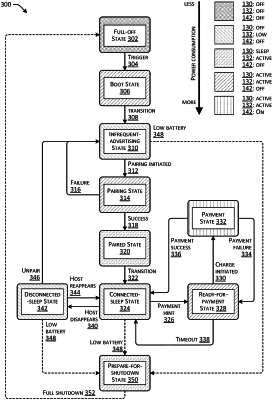| CPC G06Q 20/401 (2013.01) [G06F 1/3296 (2013.01); G06Q 20/20 (2013.01); G06Q 20/3829 (2013.01); H04L 9/14 (2013.01); G06Q 2220/00 (2013.01)] | 20 Claims |

|
7. A system comprising:
one or more processors; and
one or more non-transitory computer-readable media storing instructions executable by the one or more processors, wherein the instructions cause the one or more processors to perform acts comprising:
establishing, by a first electronic device, a first secure session between the first electronic device and a remote server via a second electronic device using at least a first key of a set of cryptographic keys, wherein the set of cryptographic keys are generated by the first electronic device;
receiving, by the first electronic device and from the second electronic device, transaction data associated with a first transaction;
receiving, by the first electronic device, payment information associated with the first transaction;
encrypting, by the first electronic device, the payment information using at least a second key of the set of cryptographic keys;
sending, by the first electronic device, the encrypted payment information to the second electronic device for sending to the remote server via the first secure session;
storing, at the first electronic device, an indication of a key location in the set of cryptographic keys;
responsive at least in part to storing the indication of the key location, transitioning, by the first electronic device, the first electronic device from a first power state to a second power state;
receiving, by the first electronic device and from the second electronic device, an indication of user input to a display associated with the second electronic device, wherein the user input is associated with a second transaction, and wherein the user input comprises at least one of adding an item to a virtual cart associated with the second transaction or navigating from a first user interface to a second user interface associated with the second transaction;
responsive at least in part to receiving the indication of the user input, transitioning, by the first electronic device, the first electronic device from the second power state to the first power state;
determining, by the first electronic device, the key location stored at the first electronic device; and
establishing, by the first electronic device, a second secure session between the first electronic device and the remote server via the second electronic device using at least a third key of the set of cryptographic keys, the third key corresponding to the key location.
|